| dc.contributor.author | Stokke, Randi | |
| dc.date.accessioned | 2017-03-22T08:26:31Z | |
| dc.date.available | 2017-03-22T08:26:31Z | |
| dc.date.created | 2016-09-13T15:24:48Z | |
| dc.date.issued | 2016 | |
| dc.identifier.citation | Journal of Medical Internet Research. 2016, 18:e187 (7), . | nb_NO |
| dc.identifier.issn | 1438-8871 | |
| dc.identifier.uri | http://hdl.handle.net/11250/2434935 | |
| dc.description.abstract | Background: Most western countries are experiencing greater pressure on community care services due to increased life expectancy and changes in policy toward prioritizing independent living. This has led to a demand for change and innovation in caring practices with an expected increased use of technology. Despite numerous attempts, it has proven surprisingly difficult to implement and adopt technological innovations. The main established technological innovation in home care services for older people is the personal emergency response system (PERS), which is widely adopted and used throughout most western countries aiming to support “aging safely in place.”
Objective: This integrative review examines how research literature describes use of the PERS focusing on the users’ perspective, thus exploring how different actors experience the technology in use and how it affects the complex interactions between multiple actors in caring practices.
Methods: The review presents an overview of the body of research on this well-established telecare solution, indicating what is important for different actors in regard to accepting and using this technology in community care services. An integrative review, recognized by a systematic search in major databases followed by a review process, was conducted.
Results: The search resulted in 33 included studies describing different actors’ experiences with the PERS in use. The overall focus was on the end users’ experiences and the consequences of having and using the alarm, and how the technology changes caring practices and interactions between the actors.
Conclusions: The PERS contributes to safety and independent living for users of the alarm, but there are also unforeseen consequences and possible improvements in the device and the integrated service. This rather simple and well-established telecare technology in use interacts with the actors involved, creating changes in daily living and even affecting their identities. This review argues for an approach to telecare in which the complexity of practice is accounted for and shows how the plug-and-play expectations producers tend to generate is a simplification of the reality. This calls for a recognition that place and actors matter, as does a sensitivity to technology as an integrated part of complex caring practices. | nb_NO |
| dc.language.iso | eng | nb_NO |
| dc.publisher | Journal of Medical Internet Research / JMIR Publications | nb_NO |
| dc.rights.uri | https://creativecommons.org/licenses/by/2.0/ | |
| dc.subject | home care services; caring practice; personal emergency alarm system; PERS; safety alarm; social alarm; telecare; review | nb_NO |
| dc.title | The personal emergency response system as a technology innovation in primary health care services: An integrative review | nb_NO |
| dc.type | Journal article | nb_NO |
| dc.type | Peer reviewed | nb_NO |
| dc.rights.holder | ©Randi Stokke. Originally published in the Journal of Medical Internet Research (http://www.jmir.org), 14.07.2016. | nb_NO |
| dc.source.pagenumber | 14 | nb_NO |
| dc.source.volume | 18:e187 | nb_NO |
| dc.source.journal | Journal of Medical Internet Research | nb_NO |
| dc.source.issue | 7 | nb_NO |
| dc.identifier.doi | 10.2196/jmir.5727 | |
| dc.identifier.cristin | 1381011 | |
| dc.description.localcode | This is an open-access article distributed under the terms of the Creative Commons Attribution License (http://creativecommons.org/licenses/by/2.0/), which permits unrestricted use, distribution, and reproduction in any medium, provided the original work, first published in the Journal of Medical Internet Research, is properly cited. The complete bibliographic information, a link to the original publication on http://www.jmir.org/, as well as this copyright and license information must be included | nb_NO |
| cristin.unitcode | 194,18,23,50 | |
| cristin.unitname | Senter for omsorgsforskning | |
| cristin.ispublished | true | |
| cristin.fulltext | original | |
| cristin.qualitycode | 2 | |

